Medical Case Report
VerifiedAdded on 2023/04/05
|7
|1357
|476
AI Summary
Noel presented to the clinic with rashes in the diaper region. The parents have no medical history of disorders and chronic illnesses. The baby has rashes in the upper thigh and lower abdomen and presents symptoms of irritation. The suspected cause of infection could be bullous impetigo, staphylococcus infection or Herpes simplex. At present the aetiology of the infection is unclear and a number of diagnostic tests are ordered. Presently the medication would include antimicrobial medication, Vancomycin, acetaminophen and oral hydration.
Contribute Materials
Your contribution can guide someone’s learning journey. Share your
documents today.
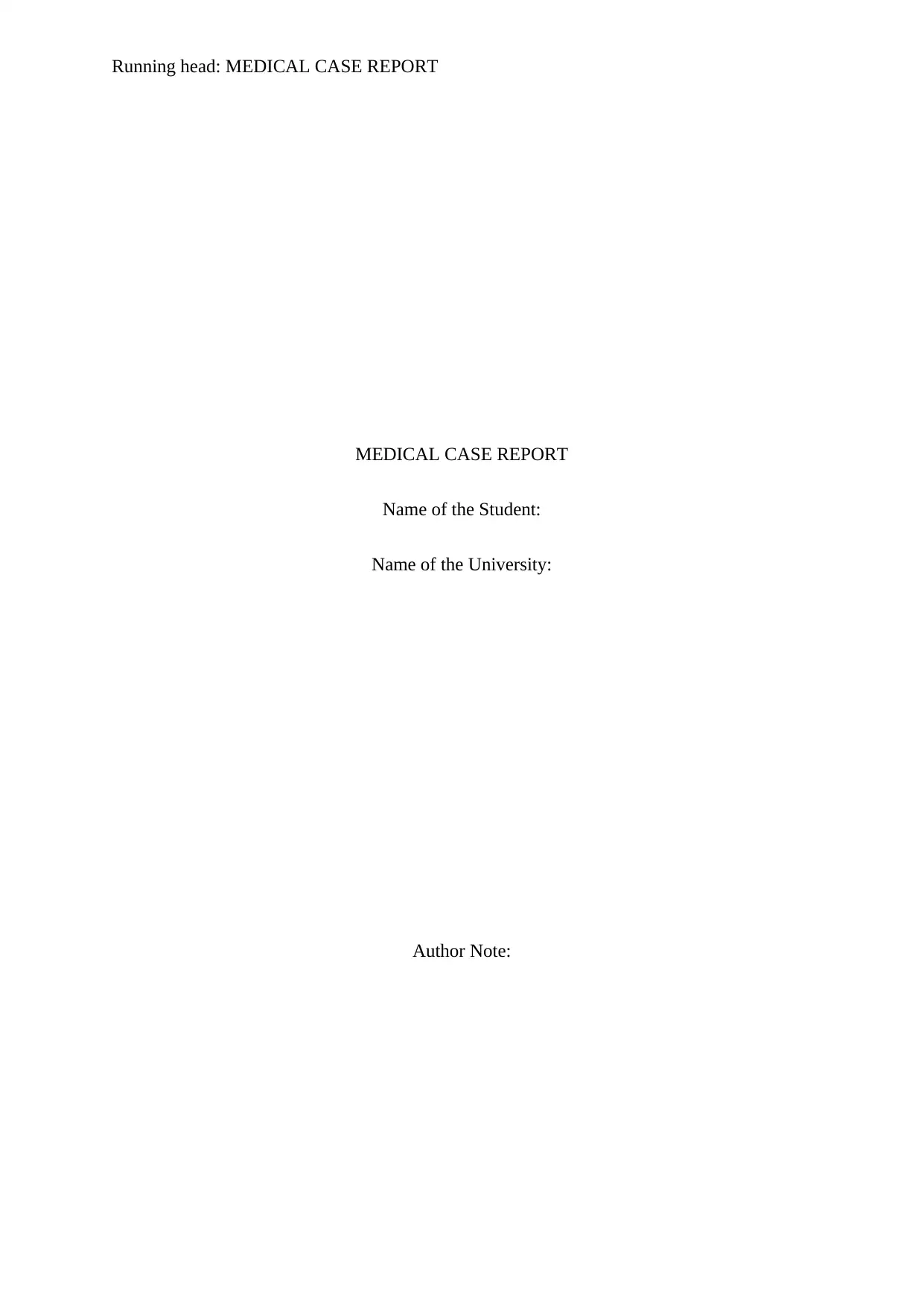
Running head: MEDICAL CASE REPORT
MEDICAL CASE REPORT
Name of the Student:
Name of the University:
Author Note:
MEDICAL CASE REPORT
Name of the Student:
Name of the University:
Author Note:
Secure Best Marks with AI Grader
Need help grading? Try our AI Grader for instant feedback on your assignments.
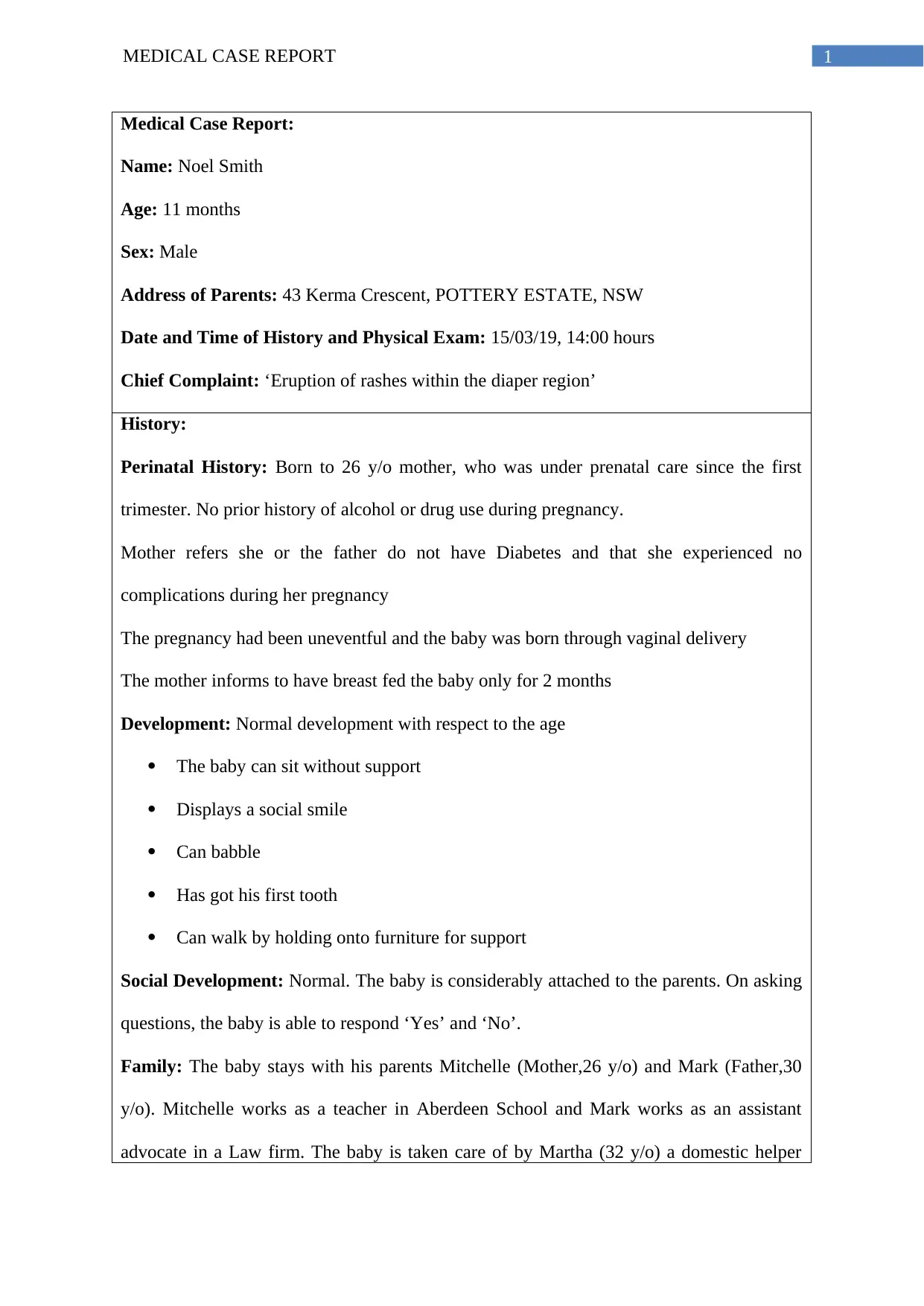
1MEDICAL CASE REPORT
Medical Case Report:
Name: Noel Smith
Age: 11 months
Sex: Male
Address of Parents: 43 Kerma Crescent, POTTERY ESTATE, NSW
Date and Time of History and Physical Exam: 15/03/19, 14:00 hours
Chief Complaint: ‘Eruption of rashes within the diaper region’
History:
Perinatal History: Born to 26 y/o mother, who was under prenatal care since the first
trimester. No prior history of alcohol or drug use during pregnancy.
Mother refers she or the father do not have Diabetes and that she experienced no
complications during her pregnancy
The pregnancy had been uneventful and the baby was born through vaginal delivery
The mother informs to have breast fed the baby only for 2 months
Development: Normal development with respect to the age
The baby can sit without support
Displays a social smile
Can babble
Has got his first tooth
Can walk by holding onto furniture for support
Social Development: Normal. The baby is considerably attached to the parents. On asking
questions, the baby is able to respond ‘Yes’ and ‘No’.
Family: The baby stays with his parents Mitchelle (Mother,26 y/o) and Mark (Father,30
y/o). Mitchelle works as a teacher in Aberdeen School and Mark works as an assistant
advocate in a Law firm. The baby is taken care of by Martha (32 y/o) a domestic helper
Medical Case Report:
Name: Noel Smith
Age: 11 months
Sex: Male
Address of Parents: 43 Kerma Crescent, POTTERY ESTATE, NSW
Date and Time of History and Physical Exam: 15/03/19, 14:00 hours
Chief Complaint: ‘Eruption of rashes within the diaper region’
History:
Perinatal History: Born to 26 y/o mother, who was under prenatal care since the first
trimester. No prior history of alcohol or drug use during pregnancy.
Mother refers she or the father do not have Diabetes and that she experienced no
complications during her pregnancy
The pregnancy had been uneventful and the baby was born through vaginal delivery
The mother informs to have breast fed the baby only for 2 months
Development: Normal development with respect to the age
The baby can sit without support
Displays a social smile
Can babble
Has got his first tooth
Can walk by holding onto furniture for support
Social Development: Normal. The baby is considerably attached to the parents. On asking
questions, the baby is able to respond ‘Yes’ and ‘No’.
Family: The baby stays with his parents Mitchelle (Mother,26 y/o) and Mark (Father,30
y/o). Mitchelle works as a teacher in Aberdeen School and Mark works as an assistant
advocate in a Law firm. The baby is taken care of by Martha (32 y/o) a domestic helper
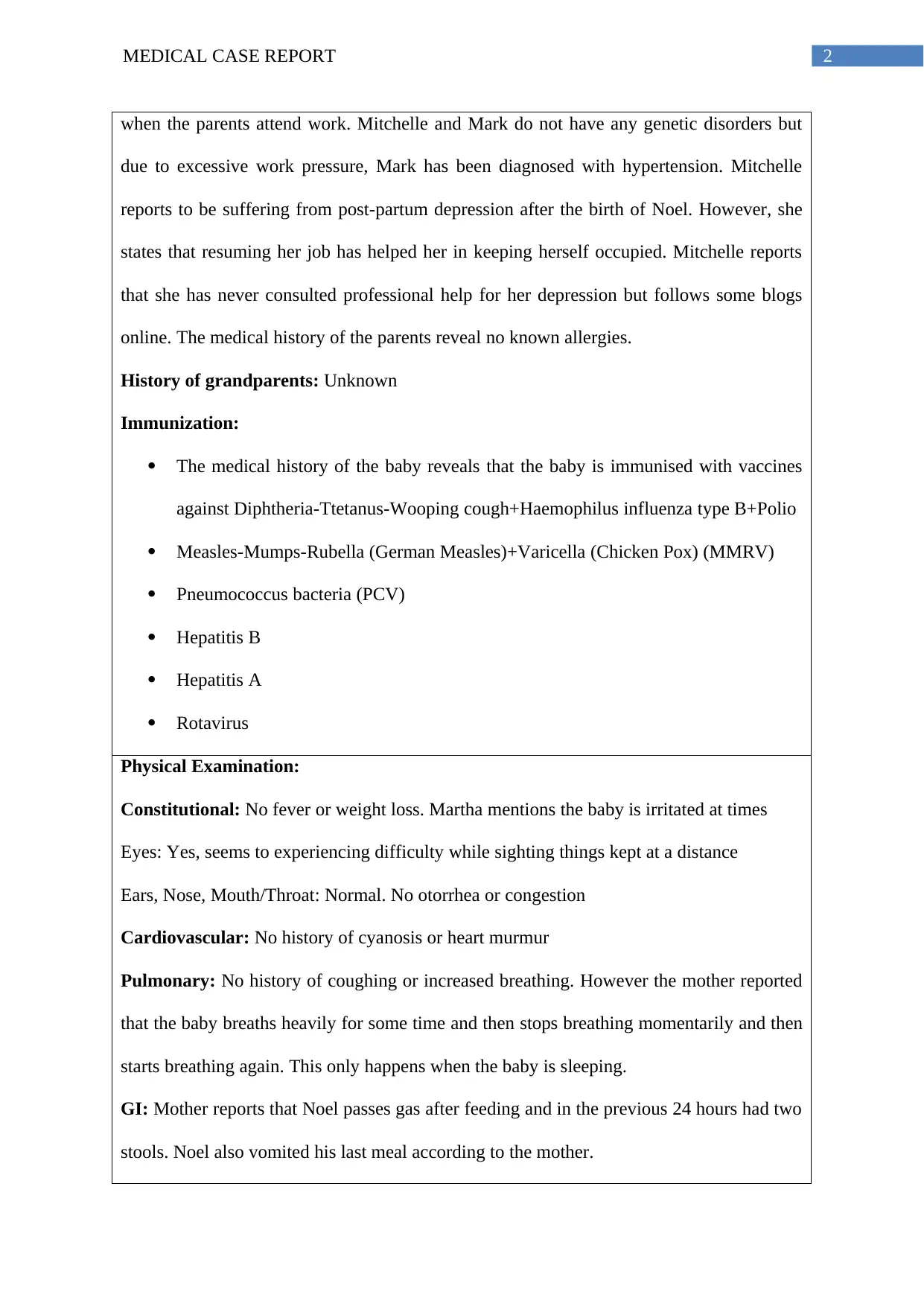
2MEDICAL CASE REPORT
when the parents attend work. Mitchelle and Mark do not have any genetic disorders but
due to excessive work pressure, Mark has been diagnosed with hypertension. Mitchelle
reports to be suffering from post-partum depression after the birth of Noel. However, she
states that resuming her job has helped her in keeping herself occupied. Mitchelle reports
that she has never consulted professional help for her depression but follows some blogs
online. The medical history of the parents reveal no known allergies.
History of grandparents: Unknown
Immunization:
The medical history of the baby reveals that the baby is immunised with vaccines
against Diphtheria-Ttetanus-Wooping cough+Haemophilus influenza type B+Polio
Measles-Mumps-Rubella (German Measles)+Varicella (Chicken Pox) (MMRV)
Pneumococcus bacteria (PCV)
Hepatitis B
Hepatitis A
Rotavirus
Physical Examination:
Constitutional: No fever or weight loss. Martha mentions the baby is irritated at times
Eyes: Yes, seems to experiencing difficulty while sighting things kept at a distance
Ears, Nose, Mouth/Throat: Normal. No otorrhea or congestion
Cardiovascular: No history of cyanosis or heart murmur
Pulmonary: No history of coughing or increased breathing. However the mother reported
that the baby breaths heavily for some time and then stops breathing momentarily and then
starts breathing again. This only happens when the baby is sleeping.
GI: Mother reports that Noel passes gas after feeding and in the previous 24 hours had two
stools. Noel also vomited his last meal according to the mother.
when the parents attend work. Mitchelle and Mark do not have any genetic disorders but
due to excessive work pressure, Mark has been diagnosed with hypertension. Mitchelle
reports to be suffering from post-partum depression after the birth of Noel. However, she
states that resuming her job has helped her in keeping herself occupied. Mitchelle reports
that she has never consulted professional help for her depression but follows some blogs
online. The medical history of the parents reveal no known allergies.
History of grandparents: Unknown
Immunization:
The medical history of the baby reveals that the baby is immunised with vaccines
against Diphtheria-Ttetanus-Wooping cough+Haemophilus influenza type B+Polio
Measles-Mumps-Rubella (German Measles)+Varicella (Chicken Pox) (MMRV)
Pneumococcus bacteria (PCV)
Hepatitis B
Hepatitis A
Rotavirus
Physical Examination:
Constitutional: No fever or weight loss. Martha mentions the baby is irritated at times
Eyes: Yes, seems to experiencing difficulty while sighting things kept at a distance
Ears, Nose, Mouth/Throat: Normal. No otorrhea or congestion
Cardiovascular: No history of cyanosis or heart murmur
Pulmonary: No history of coughing or increased breathing. However the mother reported
that the baby breaths heavily for some time and then stops breathing momentarily and then
starts breathing again. This only happens when the baby is sleeping.
GI: Mother reports that Noel passes gas after feeding and in the previous 24 hours had two
stools. Noel also vomited his last meal according to the mother.
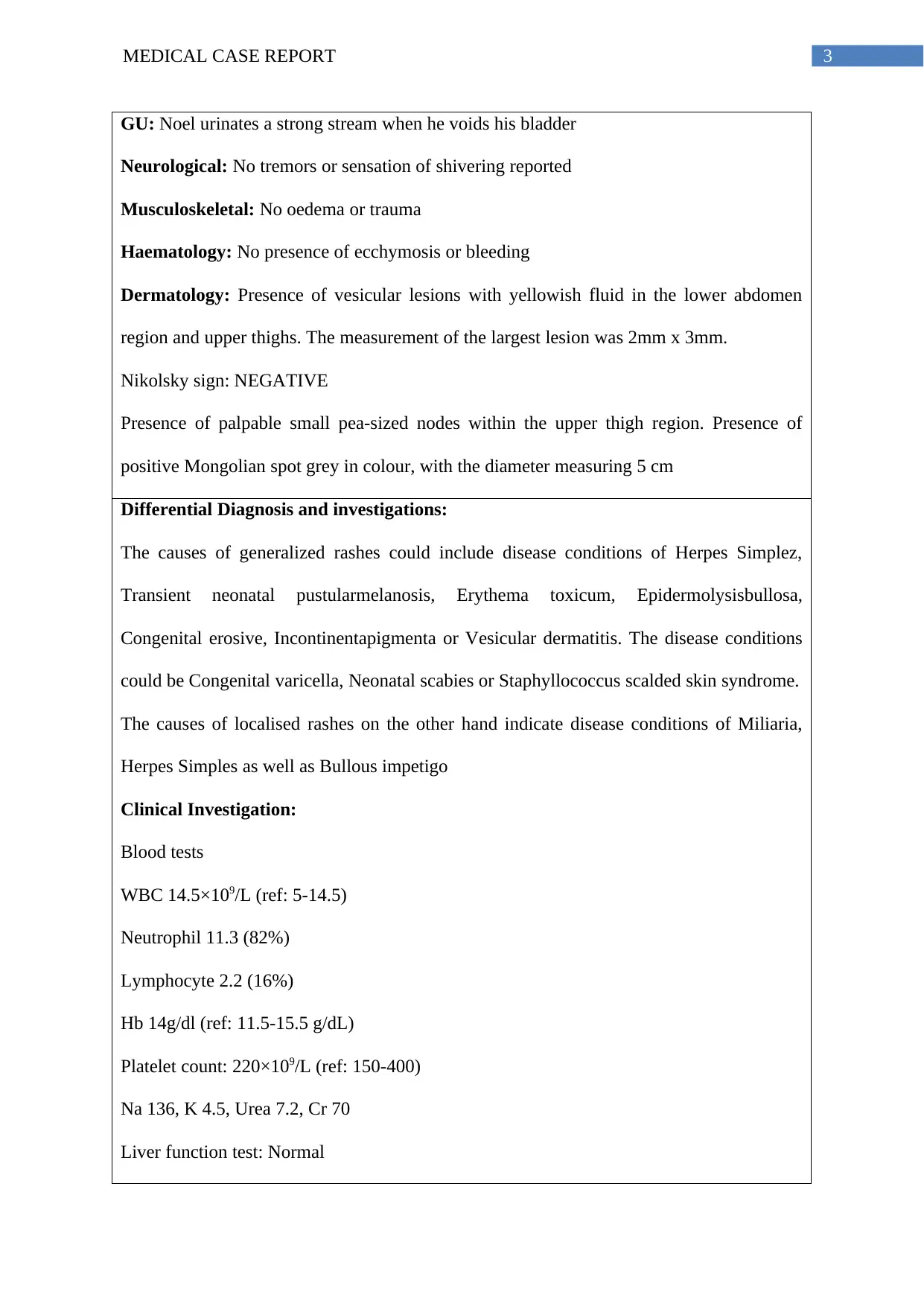
3MEDICAL CASE REPORT
GU: Noel urinates a strong stream when he voids his bladder
Neurological: No tremors or sensation of shivering reported
Musculoskeletal: No oedema or trauma
Haematology: No presence of ecchymosis or bleeding
Dermatology: Presence of vesicular lesions with yellowish fluid in the lower abdomen
region and upper thighs. The measurement of the largest lesion was 2mm x 3mm.
Nikolsky sign: NEGATIVE
Presence of palpable small pea-sized nodes within the upper thigh region. Presence of
positive Mongolian spot grey in colour, with the diameter measuring 5 cm
Differential Diagnosis and investigations:
The causes of generalized rashes could include disease conditions of Herpes Simplez,
Transient neonatal pustularmelanosis, Erythema toxicum, Epidermolysisbullosa,
Congenital erosive, Incontinentapigmenta or Vesicular dermatitis. The disease conditions
could be Congenital varicella, Neonatal scabies or Staphyllococcus scalded skin syndrome.
The causes of localised rashes on the other hand indicate disease conditions of Miliaria,
Herpes Simples as well as Bullous impetigo
Clinical Investigation:
Blood tests
WBC 14.5×109/L (ref: 5-14.5)
Neutrophil 11.3 (82%)
Lymphocyte 2.2 (16%)
Hb 14g/dl (ref: 11.5-15.5 g/dL)
Platelet count: 220×109/L (ref: 150-400)
Na 136, K 4.5, Urea 7.2, Cr 70
Liver function test: Normal
GU: Noel urinates a strong stream when he voids his bladder
Neurological: No tremors or sensation of shivering reported
Musculoskeletal: No oedema or trauma
Haematology: No presence of ecchymosis or bleeding
Dermatology: Presence of vesicular lesions with yellowish fluid in the lower abdomen
region and upper thighs. The measurement of the largest lesion was 2mm x 3mm.
Nikolsky sign: NEGATIVE
Presence of palpable small pea-sized nodes within the upper thigh region. Presence of
positive Mongolian spot grey in colour, with the diameter measuring 5 cm
Differential Diagnosis and investigations:
The causes of generalized rashes could include disease conditions of Herpes Simplez,
Transient neonatal pustularmelanosis, Erythema toxicum, Epidermolysisbullosa,
Congenital erosive, Incontinentapigmenta or Vesicular dermatitis. The disease conditions
could be Congenital varicella, Neonatal scabies or Staphyllococcus scalded skin syndrome.
The causes of localised rashes on the other hand indicate disease conditions of Miliaria,
Herpes Simples as well as Bullous impetigo
Clinical Investigation:
Blood tests
WBC 14.5×109/L (ref: 5-14.5)
Neutrophil 11.3 (82%)
Lymphocyte 2.2 (16%)
Hb 14g/dl (ref: 11.5-15.5 g/dL)
Platelet count: 220×109/L (ref: 150-400)
Na 136, K 4.5, Urea 7.2, Cr 70
Liver function test: Normal
Secure Best Marks with AI Grader
Need help grading? Try our AI Grader for instant feedback on your assignments.
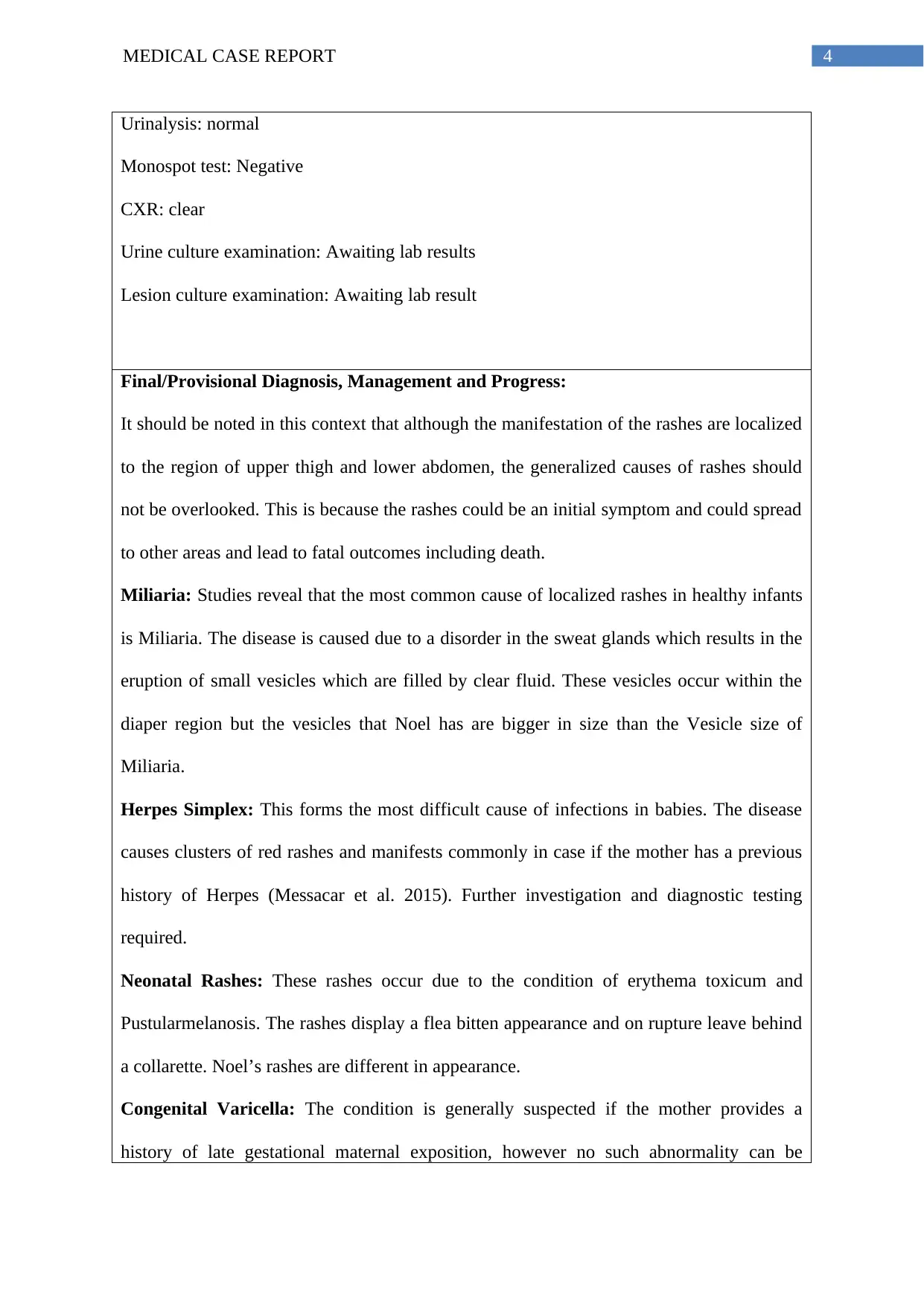
4MEDICAL CASE REPORT
Urinalysis: normal
Monospot test: Negative
CXR: clear
Urine culture examination: Awaiting lab results
Lesion culture examination: Awaiting lab result
Final/Provisional Diagnosis, Management and Progress:
It should be noted in this context that although the manifestation of the rashes are localized
to the region of upper thigh and lower abdomen, the generalized causes of rashes should
not be overlooked. This is because the rashes could be an initial symptom and could spread
to other areas and lead to fatal outcomes including death.
Miliaria: Studies reveal that the most common cause of localized rashes in healthy infants
is Miliaria. The disease is caused due to a disorder in the sweat glands which results in the
eruption of small vesicles which are filled by clear fluid. These vesicles occur within the
diaper region but the vesicles that Noel has are bigger in size than the Vesicle size of
Miliaria.
Herpes Simplex: This forms the most difficult cause of infections in babies. The disease
causes clusters of red rashes and manifests commonly in case if the mother has a previous
history of Herpes (Messacar et al. 2015). Further investigation and diagnostic testing
required.
Neonatal Rashes: These rashes occur due to the condition of erythema toxicum and
Pustularmelanosis. The rashes display a flea bitten appearance and on rupture leave behind
a collarette. Noel’s rashes are different in appearance.
Congenital Varicella: The condition is generally suspected if the mother provides a
history of late gestational maternal exposition, however no such abnormality can be
Urinalysis: normal
Monospot test: Negative
CXR: clear
Urine culture examination: Awaiting lab results
Lesion culture examination: Awaiting lab result
Final/Provisional Diagnosis, Management and Progress:
It should be noted in this context that although the manifestation of the rashes are localized
to the region of upper thigh and lower abdomen, the generalized causes of rashes should
not be overlooked. This is because the rashes could be an initial symptom and could spread
to other areas and lead to fatal outcomes including death.
Miliaria: Studies reveal that the most common cause of localized rashes in healthy infants
is Miliaria. The disease is caused due to a disorder in the sweat glands which results in the
eruption of small vesicles which are filled by clear fluid. These vesicles occur within the
diaper region but the vesicles that Noel has are bigger in size than the Vesicle size of
Miliaria.
Herpes Simplex: This forms the most difficult cause of infections in babies. The disease
causes clusters of red rashes and manifests commonly in case if the mother has a previous
history of Herpes (Messacar et al. 2015). Further investigation and diagnostic testing
required.
Neonatal Rashes: These rashes occur due to the condition of erythema toxicum and
Pustularmelanosis. The rashes display a flea bitten appearance and on rupture leave behind
a collarette. Noel’s rashes are different in appearance.
Congenital Varicella: The condition is generally suspected if the mother provides a
history of late gestational maternal exposition, however no such abnormality can be
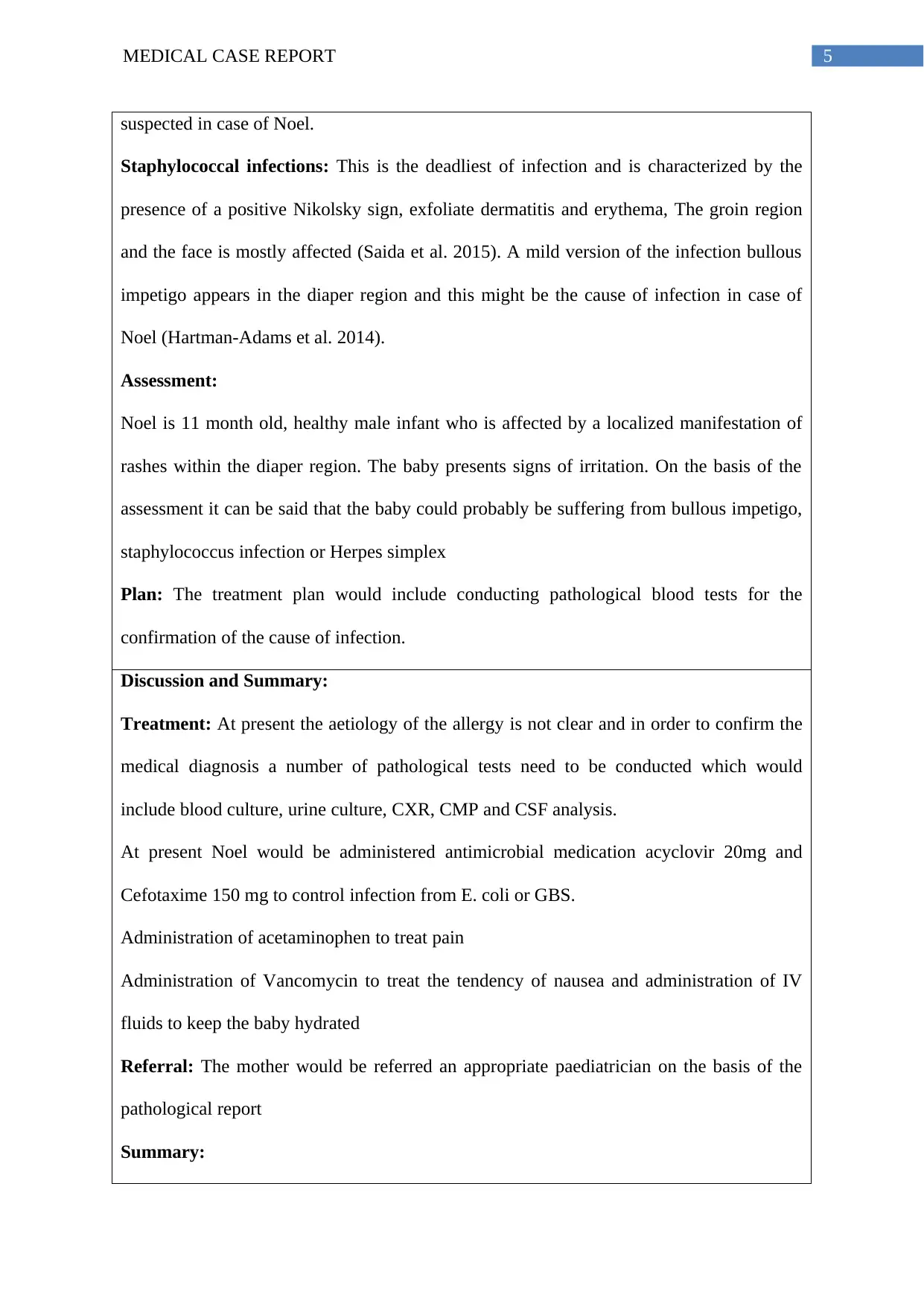
5MEDICAL CASE REPORT
suspected in case of Noel.
Staphylococcal infections: This is the deadliest of infection and is characterized by the
presence of a positive Nikolsky sign, exfoliate dermatitis and erythema, The groin region
and the face is mostly affected (Saida et al. 2015). A mild version of the infection bullous
impetigo appears in the diaper region and this might be the cause of infection in case of
Noel (Hartman-Adams et al. 2014).
Assessment:
Noel is 11 month old, healthy male infant who is affected by a localized manifestation of
rashes within the diaper region. The baby presents signs of irritation. On the basis of the
assessment it can be said that the baby could probably be suffering from bullous impetigo,
staphylococcus infection or Herpes simplex
Plan: The treatment plan would include conducting pathological blood tests for the
confirmation of the cause of infection.
Discussion and Summary:
Treatment: At present the aetiology of the allergy is not clear and in order to confirm the
medical diagnosis a number of pathological tests need to be conducted which would
include blood culture, urine culture, CXR, CMP and CSF analysis.
At present Noel would be administered antimicrobial medication acyclovir 20mg and
Cefotaxime 150 mg to control infection from E. coli or GBS.
Administration of acetaminophen to treat pain
Administration of Vancomycin to treat the tendency of nausea and administration of IV
fluids to keep the baby hydrated
Referral: The mother would be referred an appropriate paediatrician on the basis of the
pathological report
Summary:
suspected in case of Noel.
Staphylococcal infections: This is the deadliest of infection and is characterized by the
presence of a positive Nikolsky sign, exfoliate dermatitis and erythema, The groin region
and the face is mostly affected (Saida et al. 2015). A mild version of the infection bullous
impetigo appears in the diaper region and this might be the cause of infection in case of
Noel (Hartman-Adams et al. 2014).
Assessment:
Noel is 11 month old, healthy male infant who is affected by a localized manifestation of
rashes within the diaper region. The baby presents signs of irritation. On the basis of the
assessment it can be said that the baby could probably be suffering from bullous impetigo,
staphylococcus infection or Herpes simplex
Plan: The treatment plan would include conducting pathological blood tests for the
confirmation of the cause of infection.
Discussion and Summary:
Treatment: At present the aetiology of the allergy is not clear and in order to confirm the
medical diagnosis a number of pathological tests need to be conducted which would
include blood culture, urine culture, CXR, CMP and CSF analysis.
At present Noel would be administered antimicrobial medication acyclovir 20mg and
Cefotaxime 150 mg to control infection from E. coli or GBS.
Administration of acetaminophen to treat pain
Administration of Vancomycin to treat the tendency of nausea and administration of IV
fluids to keep the baby hydrated
Referral: The mother would be referred an appropriate paediatrician on the basis of the
pathological report
Summary:
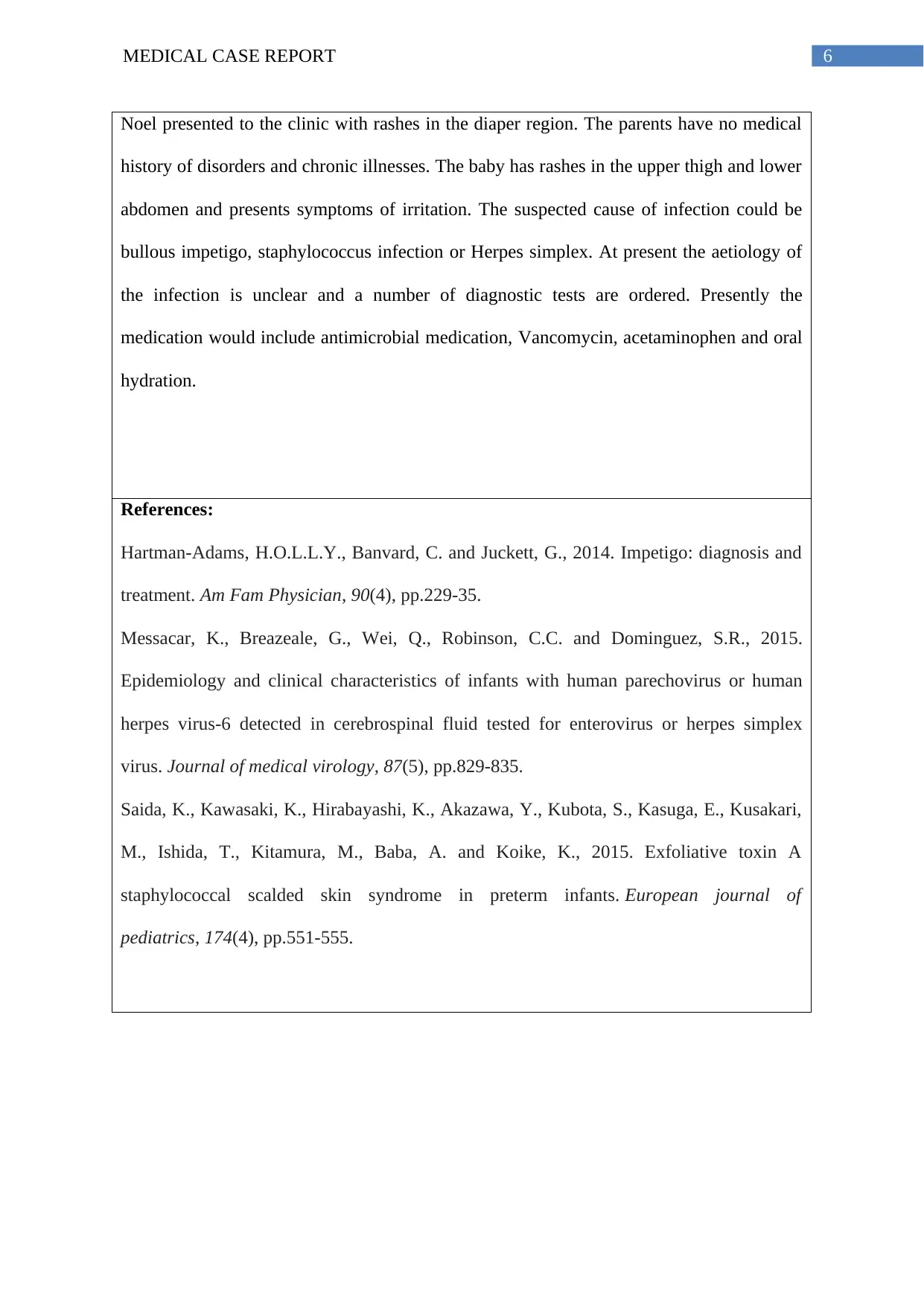
6MEDICAL CASE REPORT
Noel presented to the clinic with rashes in the diaper region. The parents have no medical
history of disorders and chronic illnesses. The baby has rashes in the upper thigh and lower
abdomen and presents symptoms of irritation. The suspected cause of infection could be
bullous impetigo, staphylococcus infection or Herpes simplex. At present the aetiology of
the infection is unclear and a number of diagnostic tests are ordered. Presently the
medication would include antimicrobial medication, Vancomycin, acetaminophen and oral
hydration.
References:
Hartman-Adams, H.O.L.L.Y., Banvard, C. and Juckett, G., 2014. Impetigo: diagnosis and
treatment. Am Fam Physician, 90(4), pp.229-35.
Messacar, K., Breazeale, G., Wei, Q., Robinson, C.C. and Dominguez, S.R., 2015.
Epidemiology and clinical characteristics of infants with human parechovirus or human
herpes virus‐6 detected in cerebrospinal fluid tested for enterovirus or herpes simplex
virus. Journal of medical virology, 87(5), pp.829-835.
Saida, K., Kawasaki, K., Hirabayashi, K., Akazawa, Y., Kubota, S., Kasuga, E., Kusakari,
M., Ishida, T., Kitamura, M., Baba, A. and Koike, K., 2015. Exfoliative toxin A
staphylococcal scalded skin syndrome in preterm infants. European journal of
pediatrics, 174(4), pp.551-555.
Noel presented to the clinic with rashes in the diaper region. The parents have no medical
history of disorders and chronic illnesses. The baby has rashes in the upper thigh and lower
abdomen and presents symptoms of irritation. The suspected cause of infection could be
bullous impetigo, staphylococcus infection or Herpes simplex. At present the aetiology of
the infection is unclear and a number of diagnostic tests are ordered. Presently the
medication would include antimicrobial medication, Vancomycin, acetaminophen and oral
hydration.
References:
Hartman-Adams, H.O.L.L.Y., Banvard, C. and Juckett, G., 2014. Impetigo: diagnosis and
treatment. Am Fam Physician, 90(4), pp.229-35.
Messacar, K., Breazeale, G., Wei, Q., Robinson, C.C. and Dominguez, S.R., 2015.
Epidemiology and clinical characteristics of infants with human parechovirus or human
herpes virus‐6 detected in cerebrospinal fluid tested for enterovirus or herpes simplex
virus. Journal of medical virology, 87(5), pp.829-835.
Saida, K., Kawasaki, K., Hirabayashi, K., Akazawa, Y., Kubota, S., Kasuga, E., Kusakari,
M., Ishida, T., Kitamura, M., Baba, A. and Koike, K., 2015. Exfoliative toxin A
staphylococcal scalded skin syndrome in preterm infants. European journal of
pediatrics, 174(4), pp.551-555.
1 out of 7
Related Documents
Your All-in-One AI-Powered Toolkit for Academic Success.
+13062052269
info@desklib.com
Available 24*7 on WhatsApp / Email
![[object Object]](/_next/static/media/star-bottom.7253800d.svg)
Unlock your academic potential
© 2024 | Zucol Services PVT LTD | All rights reserved.



